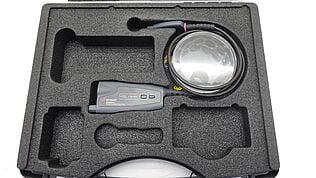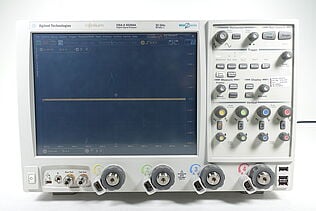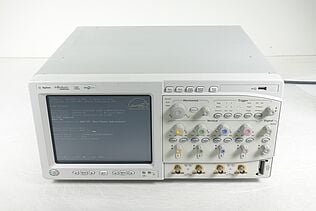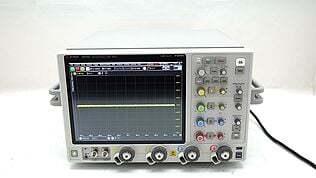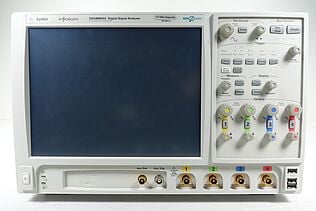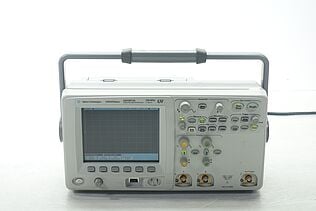- Introduction
- Understanding the Vertical Scale
- Importance in Signal Analysis
- The Process of Translating Electrical Signals into Visual Outputs
- Key Features of the Vertical Scale in Oscilloscopes
- Scale Settings
- Types of Vertical Controls
- How To Use Vertical Scale Correctly
- Best Practices
- Troubleshooting Common Issues
- Vertical Scale in Different Types of Oscilloscopes
- Specialized Oscilloscopes
- Conclusion
- Whenever You’re Ready, Here Are 5 Ways We Can Help You
Have you ever wondered how electrical signals, invisible to the naked eye, become quantifiable data? The answer lies in the functionality of an oscilloscope, particularly in its vertical scale.
This feature is crucial for professionals in electronics and electrical engineering fields, turning abstract electrical signals into understandable visual representations.
Understanding the Vertical Scale
The vertical scale on an oscilloscope is a critical component that determines how signal voltages are displayed on the screen. It allows users to adjust the amplitude of the signal being measured, essentially controlling how tall the waveform appears on the display.
Importance in Signal Analysis
- Accuracy in measurement: Ensures precise amplitude readings.
- Comparative analysis: Facilitates comparison between multiple waveforms.
- Signal integrity: Aids in assessing the quality and stability of the signal.
| Key Takeaway |
|---|
| The vertical scale in oscilloscopes is essential for accurately displaying and measuring the amplitude of electrical signals. Careful adjustments and understanding of this setting are crucial for precise signal analysis and interpretation. |
Thousands Of Engineers Trust Keysight Oscilloscopes
The Process of Translating Electrical Signals into Visual Outputs
The vertical scale in oscilloscopes plays a pivotal role in transforming electrical signals into comprehensible visual formats. This process involves several key steps, each contributing to how the final waveform is displayed on the oscilloscope screen.
Step 1: Input Signal Reception
- Signal acquisition: The oscilloscope first receives an electrical signal, which can be from various sources like circuits, sensors, or other electronic devices.
- Initial processing: This signal is then prepared for further processing by the oscilloscope's internal circuitry.
Step 2: Amplification or Attenuation
- Vertical scales role: The core of the vertical scale's functionality lies in its ability to either amplify or attenuate the input signal.
- Based on set scale: This adjustment is directly influenced by the vertical scale setting chosen by the user. The scale setting determines the sensitivity of the oscilloscope to the input signal.
- Outcome: The result is either an enlarged or reduced representation of the signal's amplitude, depending on whether the signal is amplified (for smaller signals) or attenuated (for larger signals).
Step 3: Display Adjustment
- Visualization of signal: After the amplification or attenuation, the oscilloscope adjusts the display to reflect the chosen scale setting.
- Adjusting vertical size: This involves changing the vertical size of the signal on the screen. The vertical scale setting dictates how much of the screen's vertical space each volt of the signal will occupy.
- Correlation with grid: The oscilloscope's screen grid, with its marked divisions, helps in aligning and interpreting the signal. Each division corresponds to a specific voltage value as per the set vertical scale, aiding in accurate measurement and analysis.
Through these steps, the vertical scale in oscilloscopes expertly converts raw electrical signals into a format that is not only visually accessible but also quantitatively precise.

Key Features of the Vertical Scale in Oscilloscopes
As we dig deeper into the nuances of the vertical scale, it's important to understand its key features. These features not only define how signals are displayed but also determine the precision and accuracy of waveform analysis.
Scale Settings
Volts/Division
- Primary setting: This is the primary setting for adjusting the vertical scale. It indicates the amount of voltage represented by each vertical division on the oscilloscope’s display.
- Customization: Users can select a setting that best fits the amplitude of the signal they are analyzing, ensuring that the waveform is neither too compressed nor excessively stretched vertically.
Fine Adjustment
- Precision control: Fine adjustment allows users to refine the vertical scale setting beyond the standard volts/division options.
- Detailed analysis: This feature is particularly useful for detailed analysis of signals, where slight variations in amplitude are critical.
Types of Vertical Controls
Variable Control
- Flexibility: Variable control offers a continuous range of adjustment, allowing users to finely tune the vertical scale.
- User-driven: It is ideal for situations where the signal amplitude is not precisely known in advance or when it varies significantly during the measurement process.
Fixed Steps
- Consistency: Fixed steps provide predefined scale steps, ensuring consistency in measurements across different signals or measurements.
- Standardization: This feature is particularly useful in standardized testing environments or when comparing multiple waveforms under consistent settings.
Advantages of Fixed Steps
- Ease of comparison: By using fixed scale steps, it is easier to compare different waveforms or repeat measurements over time, as the scale remains consistent.
- Reduced setup time: Fixed steps reduce the time and effort required to set up the oscilloscope, especially in routine testing scenarios.
- Standardized documentation: For documentation purposes, fixed steps ensure that all measurements are recorded under a uniform scale, facilitating better understanding and comparison of data.
The key features of the vertical scale, including scale settings and types of vertical controls, are essential for the effective use and understanding of oscilloscopes.
Whether it's through variable control for flexible adjustments or fixed steps for consistent measurements, these features empower users to accurately capture and analyze electrical signals.
How To Use Vertical Scale Correctly
It's important to use the vertical scale on an oscilloscope correctly for accurate signal analysis. By following best practices and understanding how to troubleshoot common issues, users can ensure they get the most precise readings from their measurements.
Best Practices
Initial Setting
- Mid-range approach: Begin with a mid-range setting on the vertical scale. This helps in initially capturing the full extent of the signal without the risk of clipping or under-representing it.
- Baseline for adjustments: Starting in the middle provides a baseline from which you can make incremental adjustments, either up or down, depending on the signal's characteristics.
Fine-Tuning
- Detail-oriented adjustments: Once you have a baseline, fine-tune the scale to enhance the clarity and detail of the waveform. This step is crucial for in-depth analysis and accurate interpretation.
- Responsive adjustments: As signals vary, continuously adjust the scale to maintain optimal visibility and precision.
Comparison
- Consistent scale settings: When comparing multiple signals, use consistent scale settings. This ensures that the differences or similarities between the waveforms are accurate and not a result of varying scale settings.
- Reliable analysis: Consistency in scale settings is key for reliable comparative analysis, especially when documenting or presenting findings.
Troubleshooting Common Issues
Clipping
- Scale reduction: If you notice the waveform is clipped or cut off at the top or bottom, reduce the scale setting (i.e., increase volts/division). This adjustment will 'shrink' the waveform vertically, fitting it within the screen.
- Signal integrity check: Ensure the entire waveform is visible for an accurate representation of the signal.
Distortion
- Scale and signal verification: If the waveform appears distorted, it's important to adjust the scale and also check the integrity of the signal. Distortion can be a result of improper scaling or a flawed input signal.
- Balancing clarity and accuracy: Find a balance between a clear waveform and an accurate representation of the signal's true characteristics.
Mastering the use of the vertical scale is crucial for effective waveform analysis in oscilloscopes. By starting with a mid-range setting, fine-tuning for clarity, maintaining consistency in comparative analysis, and effectively troubleshooting issues like clipping and distortion, users can ensure they extract precise and valuable information from their electronic measurements.
Vertical Scale in Different Types of Oscilloscopes
| Feature | Digital Oscilloscope | Analog Oscilloscope |
| Scale Control | Digital adjustment with precise steps | Manual knob with variable adjustment |
| Display | Digital screen, often with color coding | Traditional cathode-ray tube display |
| Memory | Can store and recall settings | Immediate, but transient display |
Specialized Oscilloscopes
- Mixed signal oscilloscopes: Offer additional channels for digital signals, each with its vertical scale.
- Storage oscilloscopes: Enable saving and recalling waveforms, preserving vertical scale settings.
Get Your Used Oscilloscope On Sale Now
Select up to 3 instruments to compare
Enable Notifications
In order to use this feature, you need to enable notifications.
Manage notification preferences
Conclusion
Vertical scale in oscilloscopes is an important feature that allows you to accurately measure and analyze electrical signals. When used correctly, it provides precise data interpretation, essential in various applications ranging from troubleshooting to research and development.
Mastering the vertical scale settings will allow you to unlock the full potential of your oscilloscopes, leading to more efficient and accurate work in the field of electronics and electrical engineering.
Keysight Used Equipment Store offers an excellent range of premium used oscilloscopes, signal analyzers, function generators, and multimeters. Explore their collection to find tools that meet your precision measurement needs, backed by the reliability and advanced technology of Keysight.

Whenever You’re Ready, Here Are 5 Ways We Can Help You
- Browse our Premium Used Oscilloscopes.
- Call tech support US: +1 800 829-4444
Press #, then 2. Hours: 7 am – 5 pm MT, Mon– Fri - Talk to our sales support team by clicking the icon (bottom right corner) on every offer page
- Create an account to get price alerts and access to exclusive waitlists.
- Talk to your account manager about your specific needs.










